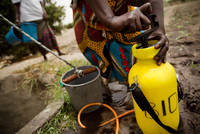Réglementation souple

Subventions:
Les gouvernements offrent des subventions directes à qui met en pratique une gestion durable des terres ou d’autres technologies environnementales.
Servitudes de conservation:
Un accord volontaire entre les propriétaires terriens et le gouvernement, les entreprises ou les ONGs, transférant les droits de développement des propriétés pour les retirer de la production. Le type et l’étendue des développements futurs sur la propriété sont donc limités. Les droits de développement achetés peuvent être par exemple échangés sur le marché de la compensation.
Compensations:
Cherche à garantir que les impacts environnementaux négatifs inévitables, provenant du développement, soient contrebalancés par des gains environnementaux, comme mesure compensatoire. L’objectif général des compensations est d’atteindre des résultats nets-neutres ou apportant des bénéfices. Les compensations peuvent être réalisées via la restauration de l’habitat, la biodiversité, l’eau, le carbone (voir ci-dessous) etc. Peuvent être échangées – Marchés pour la réduction de la pollution / des émissions.
Example
Example
METSO II, Finland: Provides subsidies to compensate commercially managed forest owners for safeguarding areas of ecologically valuable forest habitat types.
Conservation Easements:
A voluntary agreement between landowners and government, industry or NGO transferring the development rights of properties to force it out of production. The type and extent of future development is then limited on the property. Purchased development rights can be traded in a market for off-setting etc.
Offsets:
Seek to ensure that unavoidable adverse environmental impacts of development are counter-balanced by environmental gains as a compensatory measures. The overall aim of offsets is to achieve a net-neutral or net-beneficial outcome.
Offsets can be made through habitat restoration, biodiversity, water, carbon, etc. and can be traded in markets for pollution/ emissions reduction.
Example
Example
| Business and Biodiversity Offsets Programme (BBOP): A collaboration between companies, financial institutions, government agencies and civil society organizations to develop best practices for mitigation (avoid, minimize, restore, offset) to achieve no net loss or gain of biodiversity, while addressing the needs of local communities. |
|---|
Marketing labels: Certificates/ standards:
Can be used to promote products, processes or services that comply with specific environmental and/or social standards. Compliance with these standards is certified by verification methods recognized and approached by a third party certification body. This party has no direct interested in the economic relationship between the supplier and the buyer.
Marketing labels and certification of products, processes or services that are linked to ecosystem input factors are more likely to require rigorous MRV. When de-linked to ecosystem input factors, assessment criteria are more likely to be less onerous.
The use of marketing labels and certificates/ standards for agricultural products can enable farmers to access higher-value markets. The transition to more sustainable agricultural production to reach these standards and obtain certification and/or marketing labels is, however, costly for farmers. They, therefore, require incentives, such as access to capital to invest in improved technologies.
Example with Government
Example with Government
International Organization for Standardization (ISO)
| International Federation of Organic Agriculture Movements (IFOAM certification) |
|---|
Example by NGOs
Example by NGOs
| |
|---|---|
| |
| |
| Wildlife Friendly - Ibis Rice Cambodia: Through improved farming practices and access to higher-value markets, Ibis Rice are able to conserve Giant Ibis habitats and support farmers to earn a higher income. |
Example by Industry
Example by Industry
Global Good Agricultural Practice (Global G.A.P.) | |
| Marine Stewardship Council (MSC) - For fisheries from sustainable stocks, with operations that have minimal environmental impact and fisheries that have effective management |
Permits and Quotas:
Permits: The right to emit a specific volume of pollutant/ extract a specific amount of natural resource.
Quota: The cap or specific amount of allowed emissions or extractions.
Emissions permits and quotas can be traded to distribute the amount of the total allowance. Parties can use their own, buy or sell allowances.
Includes:
- Compliant Carbon Market - Regulated (Kyoto Protocol) formal carbon-trading mechanism and market, such as Carbon Development Mechanisms (CDM), referred to as Compliant Emissions Reductions (CERs). Driven by mandated caps on greenhouse gas emissions.
- Voluntary Carbon Market - A form of CSR (see above), with a focus on carbon offset transactions. Also includes speculative pre-compliance offsets. Two primary methods for trading voluntary carbon credits are:
- Chicago Climate Exchange (CCX) Voluntary but legally binding.
- ‘Over-the Counter’ (OTC) Non-binding off-set market, referred to as Voluntary Emissions Reductions (VERs).
Example
Example
| EU Emissions Trading Scheme (EU-ETS): A market-based regulatory compliance mechanism that allows carbon-polluting industries to buy and sell credits to offset their carbon dioxide emissions to comply with EU-mandated targets, based ont he Kyoto Protocol |
|---|---|
| REDD / Forest carbon |
Corporate Social Responsibility (CSR):
A business strategy to participate in or integrate initiatives that benefit society and the environment into their operations. Driven by a variety of considerations related to green philanthropy and sponsoring, insetting: integrating business value chain or impact marketing.
CSR can incorporate issues ranging from prevention of environmental pollution, sustainable use of resources, climate change mitigation, supply chain eco-efficiency and responsible sourcing to improved stakeholder engagement, sustainable consumption, social equity and good governance.
ISO 26000 provides guidance on how businesses and organizations can operate in a social responsible way.
Example
Example
| Hagen Daz and Honeybee Preservation: Hagen Daz is donating a portion of profits from Hagen Daz honeybee brand to UC Davis to research honeybee conservation. |
|---|











